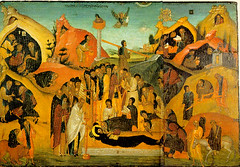O Lord and Master of my life, give me not a spirit of sloth, vain curiosity, lust for power, and idle talk (great metanoia).
But give to me Thy servant a spirit of soberness, humility, patience, and love (great metanoia).
O Lord and King, grant me to see my own faults and not to condemn my brother (metanoia).
O Lord, be gracious to me, the sinner (twelve times, with a small metanoia after each).
O Lord and King, grant me to see my own faults and not to condemn my brother: for blessed art Thou to the ages of ages. Amen (metanoia).
Rivaled only by the Jesus prayer and Kyrie eleison in its conciseness, the prayer of Saint Ephraim the Syrian, an ascetic fourth-century church father, is unique in its combining of great and small metanoiai, or prostrations, with the text. But that's not the aspect of diataxis that is on my mind today with regards to the prayer.
Texts reflecting on the prayer's beauty and power, as well as its place in the lenten services abound. There are, however, two specific aspects of its historical place in the liturgical life of the Eastern Orthodox Church which I would like to underline.
First, common knowledge has it that it is used only during the great Paschal fast. The preciseness of sinaitic typika, however, also call for the prayer and its metanoiai to be used at two other times: Mondays, Wednesdays and Fridays of the Nativity fast and fast of the Apostles'. Why Mondays, Wednesdays and Fridays? As you probably know, these are the fast days in monasteries. Therefore, the services on these days during the Nativity and Apostles fasts actually follow the lenten order of services! This is expressed via the use of Alleluia in the Orthros instead of the Apolytikion of the day. The Great Apodeipnon, or Compline, and Mid-Hour Services are also used on these days. But even this somewhat obscure detail is not the main point of what I share today.
This second aspect of the prayer's diataxis is, I think, the most potent. The strange thing is that you don't even need an ancient Typikon to find it; it's right there in the Horologion and Triodion books. While the above rubric of using the prayer in the Nativity and Apostles' fasts has mostly fallen out of use today, even in the Athonite monasteries, this second aspect has not. It is how the prayer is used both throughout Mount Athos and monasteries elsewhere, still closely following the ancient taxis.
This most powerful aspect of the use of the Prayer of Ephraim is indicated by the use of two words, either "mystikos" or "kath' heauton." In English these words can be translated as "mystically," or "to oneself." Simply put, the prayer and its metanoiai are called to be performed in silence.
The picture is quite powerful, if you can imagine a church full of monks all doing their prostrations and crosses in silence. All that is heard is the swoosh of their robes as they fall down and rise up again.
I think this is a most uniquely private moment in the mystical liturgical worship of the Eastern Church.
It's no wonder that varying opinions exist today as to how to actually deal with the prayer in parish worship. One priest will read the prayer and make all the prostrations with each verse, another will simply read the three verses without making the prostrations and a bishop elsewhere will even just skip the prayer altogether! How could such diversity of practice be explained? Easily. The actual rubric has been suppressed. This is often the case with discrepancies in practice, but that's another story.
Can the practice be implemented in parish life? My experience is that there are times when it can be slipped in. The first compunctual vespers may not be the ideal moment, though. At some point during the first week of the great fast, however, it could be addressed and introduced. Often, the weekday services of the great Fast are attended by a smaller number of worshipers, offering a beautifully intimate worship atmosphere. Also, they are many times congregants that have a developed liturgical sense and who often also attend adult educational, catechetical and faith enrichment gatherings. Their hearts are often warmed with the experience of such liturgical practices. But the liturgical worship services of the Church is not the only environment where this powerful rubric can bring forth spiritual fruit.
The prayer of Saint Ephraim the Syrian can be used as a centerpiece for the believer's personal prayer life during the fasts. Today's hectic life, zealous for our every waking moment is all too often the excuse for a weak or even non-existent prayer life from Sunday to Sunday for many. This is also a primary spiritual argument why many find it so hard to fast today. Without at least an attempt at living prayer true fasting is virtually impossible. The beloved saint of the twentieth century, Saint Nektarios the wonderworker and bishop of Pentapolis also connected fasting with the preparation for the mystery of holy Repentance, Confession. Isn't this the preparation for the great Pascha?
Therefore, whether one learns to make the prayer of Saint Ephraim out loud or in silence, the prayer of Saint Ephraim the Syrian, I have seen, can be a positive element in a parish's or individual's spiritual life. It warms hearts, enlivens prayer and brings us into Christ's presence in a profound, time-tested way.
I've said enough; I've said too much.

